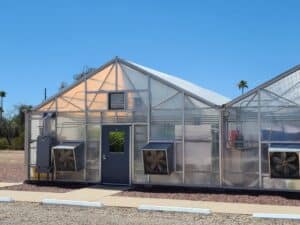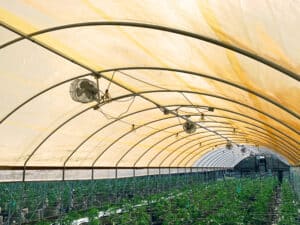
The Importance of Light Diffusion on Your Canopy

The horticultural industry is always looking for new ways to optimize yields in a sustainable manner, with a focus on greenhouse lighting crops correctly and efficiently. When we discuss lighting for crops, we tend to define optimal plant growth lighting with three measurements: light intensity (or quantity), light duration (or photoperiod), and light quality (spectrum and distribution), including the benefits of light diffusion.
With the onslaught of so many LED supplemental lighting companies coming into the industry, there have been many studies conducted on light quality from the light spectrum, including the advantages of greenhouse light diffusion. What is the right spectrum of light for your crop, and at what stage of growth is each spectrum appropriate? For example, is a higher proportion of orange and red light in the spectrum beneficial for flowering and fruit production? Additionally, understanding the benefits of light diffusion in this context can enhance crop yield and health.
But light distribution, achieved through control of greenhouse light diffusion, is often overlooked when discussing light quality for plants. Light quality should not only be thought of as light spectrum but also should include diffusion. From sunlight to supplemental lighting, let’s take a look at greenhouse light diffusion and its critical role in optimizing plant growth and maximizing the benefits in horticultural practices.
What Is Light Diffusion In Greenhouse Lighting
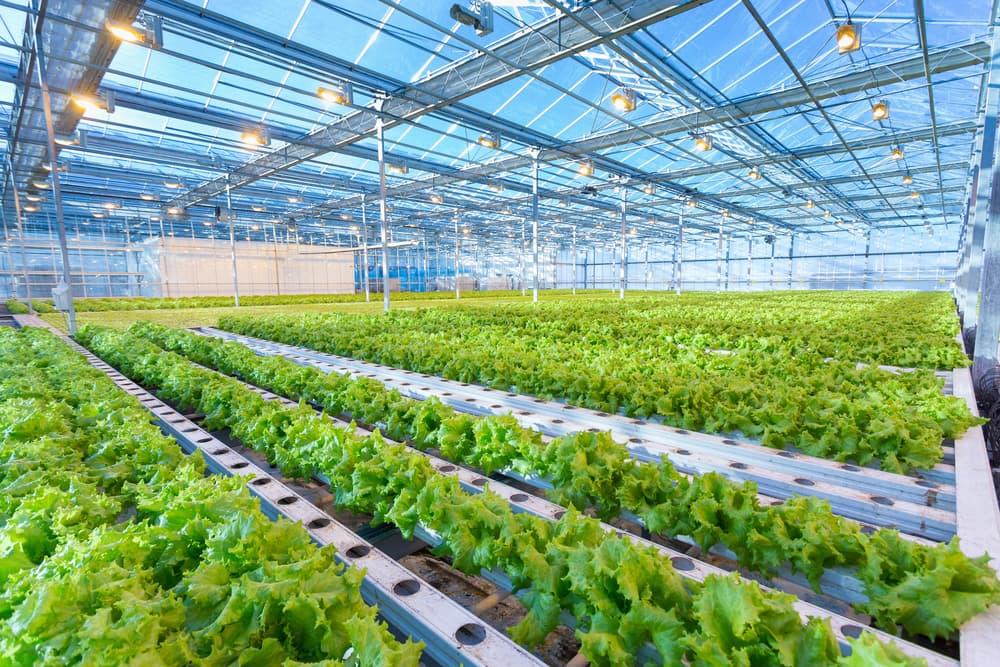
Simply put, light diffusion in the context of greenhouse lighting is the scattering of light, which is crucial for optimal plant growth. It involves photons bouncing around in all directions, ensuring even exposure to plants. The opposite of diffuse light is directional light where photons travel all in the same direction, which can be less effective in a greenhouse setting aimed at promoting plant health. Think about standing under a large outdoor shelter when the sun is highest in the sky. If there was no diffusion of light at all, it would be very bright outside the shelter but totally dark under the shade of it. The reason we can still see well in the shade, and why plants can thrive under light diffusion, is the natural diffusion of sunlight by our atmosphere, and that sunlight bounces off objects and scatters into the shelter, mimicking an optimal light diffusion scenario for plant growth in greenhouses.
Photons from the sun get scattered as they penetrate our atmosphere and bounce around in the air, enabling us to see objects that are not directly illuminated by the sun and facilitating the process of light diffusion necessary for greenhouse cultivation. This natural diffusion of sunlight is also why the sky looks blue and is integral to achieving the right light diffusion for greenhouse lighting. This is called “Rayleigh Scattering” (named after the nineteenth-century British physicist Lord Rayleigh) which states that the shorter wavelength of blue light that is higher energy gets scattered by air molecules in our atmosphere that are smaller than the wavelengths of light themselves. The high energy, shorter wavelength, of blue gets scattered much more than the longer wavelength photons in the visible spectrum, contributing to the light diffusion beneficial for plant growth in greenhouses.
Conversely, when we see clouds in the sky that look white, this is because the water droplets in the sky are larger than the wavelengths of light so they capture and scatter all of the colors of the light spectrum, making them appear white. This type of natural light diffusion by clouds, referred to as “Mie Scattering” (named after German physicist Gustav Mie), is another example of light diffusion that can be mimicked in greenhouse lighting strategies to enhance plant growth by ensuring a balanced diffusion of light.
Now that we understand light diffusion, why is it so important for contributing to light quality in horticulture?
Greenhouse Lighitng and Light Quality
Plants have evolved for millions of years and are very efficient in utilizing the sun’s rays for photosynthesis. As we began cultivating plants for food, there was a long part of our history during which we only farmed and cultivated plants that grew naturally in our local environment. Today, as our population grows and concentrates in urban areas, there is an increasing demand to sustainably grow our food closer to our population centers. Greenhouse-controlled environment agriculture, with its advanced greenhouse lighting systems, is the best solution to serve this demand, ensuring optimal plant growth through precise light quality management.
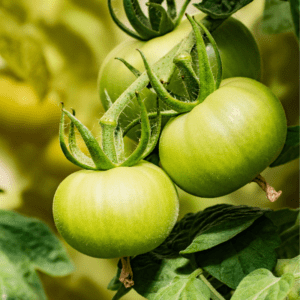
As my example above stated, sunlight is naturally diffused in our atmosphere. Plants have learned to utilize direct sunlight with their large canopy leaves as well as utilizing diffused light (or indirect light) in their leaves on lower branches. Plants are very efficient at utilizing light for photosynthesis at all levels in the canopy. As we continue to grow more crops in greenhouses and, to a lesser extent, indoors, there are more studies being done to show the importance of ensuring there is good diffusion in these facilities to optimize light quality for greenhouse lighting. This is crucial for achieving optimal plant growth, highlighting the importance of light diffusion technology in enhancing the efficiency of photosynthesis throughout the plant canopy.
Horizontal Distribution in Greenhouse Lighting
Recent studies have shown that uniform distribution of light caused by diffusion, a key aspect of greenhouse lighting, can increase overall photosynthesis and production for optimal plant growth. A study in 2015 by the Chinese Academy of Agricultural Sciences stated: “Diffuse light improves spatial light distribution in the crop canopy, thereby stimulating crop photosynthesis; the more uniform horizontal light distribution within the canopy plays the most important role for this effect in greenhouse lighting. Diffuse light also lessens the variation of the temporal light distribution at any specific point in the canopy.” This study utilized glass greenhouse glazing with high light diffusion and maintained high light transmission for optimal plant growth.
Another more recent study on light diffusion on cucumbers by Wageningen University stated: “Diffuse light has a positive influence on the production of cucumbers, especially during the summer, for greenhouse lighting. This positive effect can be explained by a change in light penetration into the crop and by an increased photosynthesis capacity, so that a crop like cucumber can utilize diffuse light better than direct light for optimal plant growth. In addition, diffuse roof material resulted in a lower crop temperature, especially higher in the crop which likely leads to more optimal conditions for photosynthesis in greenhouse lighting.” With a higher diffuse light component, not only were the plants able to photosynthesize better in the lower canopy, but better temperature uniformity also aided in overall plant health and optimal plant growth.
Does Supplemental Lighting Diffuse Light for Optimal Plant Growth?
The horticultural supplemental lighting industry has known the importance of light diffusion for greenhouse lighting and optimal plant growth for years. Have you ever noticed how HID lighting manufacturers all have reflectors that are “dimpled”? If you look at your shadow under an HID light with a dimpled reflector, you will see that your shadow under these luminaires looks blurry on the edges and is not very dark. This is because those dimples in the reflector are diffusing light. Conversely, if you look at your shadow under an LED light which does not utilize a reflector, you will see a darker shadow with defined edges because LEDs provide much more directional light.
While LEDs can reach high light levels with less power, they simply do not diffuse light or spread it uniformly on the canopy which can cause “hot spots” and uneven growth. This drawback is magnified by some of the higher output greenhouse-specific LEDs. Some LED companies even tout that their directional LEDs are optimal because HID reflectors “waste light by bouncing photons all over instead of concentrating them toward the canopy,” but as we just learned above, light diffusion is actually optimal for better photosynthesis – especially if you are utilizing lights for your sole light source in a room with reflective surfaces on the walls for optimal plant growth.
LED Controversy

You can spend time scouring the web and see images from LED grow light companies with their lights above a canopy of cannabis. When you take a closer look and compare to that of HID and HPS, you will instantly notice how dark the plants look underneath the top canopy due to shadowing.
However, to be clear I am by no means saying HID or HPS is the better light choice. I’ve covered this topic back in my days with one of the leading horticultural lighting companies in the world and I believe both technologies have their place in the industry. Some growers have definitely proven better yields and flavor profiles because of the possible spectral advantages of LEDs. I believe the LED manufacturers will soon combine the known light quality advantages of the spectrum while also utilizing light diffusion in combination for optimum performance.
Some LED manufacturers are already embracing this truth as stated by Osram in the following HortiDaily article: “Current LED fixtures often have a Lambertian primary lens and no secondary optic, or a simple glass cover, which lead to hotspots with a high concentration of light directly under the luminaire. The result is areas with different intensities of illumination, causing inconsistent yields.” LED companies like Osram are looking for and developing ways to better diffuse light for this reason.
UbiGro brings this nanotechnology to greenhouses by not only altering the sun’s spectrum for optimal photosynthesis but also diffusing these photons in a greenhouse. UbiGro acts as a sun-activated layer of light in a greenhouse. It increases the proportion of the most photosynthetically active light in the spectrum (orange-red) as well as mixing up sunlight’s directionality to create a more diffuse light environment for plants.

Recently, we have begun a study with only 50% coverage of our UbiGro Inner 600 in a greenhouse, focusing on the benefits of light diffusion. An initial reaction when looking at the picture above is that some areas of the canopy will be utilizing the optimal red-shifted spectrum from UbiGro, while other areas in the gap are receiving the directional sunlight. Perhaps surprisingly, this is not the case. When intensity and spectral data are recorded from various positions in the canopy, we find that the light levels are uniform and the spectrum is consistent whether measured under UbiGro or in the open space between the suspended strips of UbiGro. Even at 50% coverage, UbiGro is diffusing sunlight so effectively that the enhanced spectrum is the same all across the canopy, as is the PAR light level, showcasing the benefits of light diffusion in a greenhouse setting.
We now understand that the optimized sun spectrum plus the light diffusion from UbiGro’s ‘layer of light’ are both contributing to increased photosynthesis, and therefore yields, for the grower. Both components of light quality – spectrum and light diffusion – are simultaneously improved by UbiGro, highlighting the significant benefits of light diffusion in enhancing greenhouse productivity.
For more information about the capabilities of the UbiGro film or questions about this post, reach out to Eric Moody directly at [email protected].

Eric Moody is UbiQD's Director of UbiGro Sales. Eric has more than 8 years of experience in the horticulture lighting industry, building relationships with greenhouse growers of all sizes and crops on optimal lighting for their growing operation, and most recently managed a North American sales team for PL Light Systems. Overall, Eric has been in sales leadership positions for more than 17 years. Eric brings with him a great understanding of the market and available technologies for growers, greenhouse facilities, and sales leadership.
Share:
Related Posts
Social
Categories
Connect With Us
Company
Resources
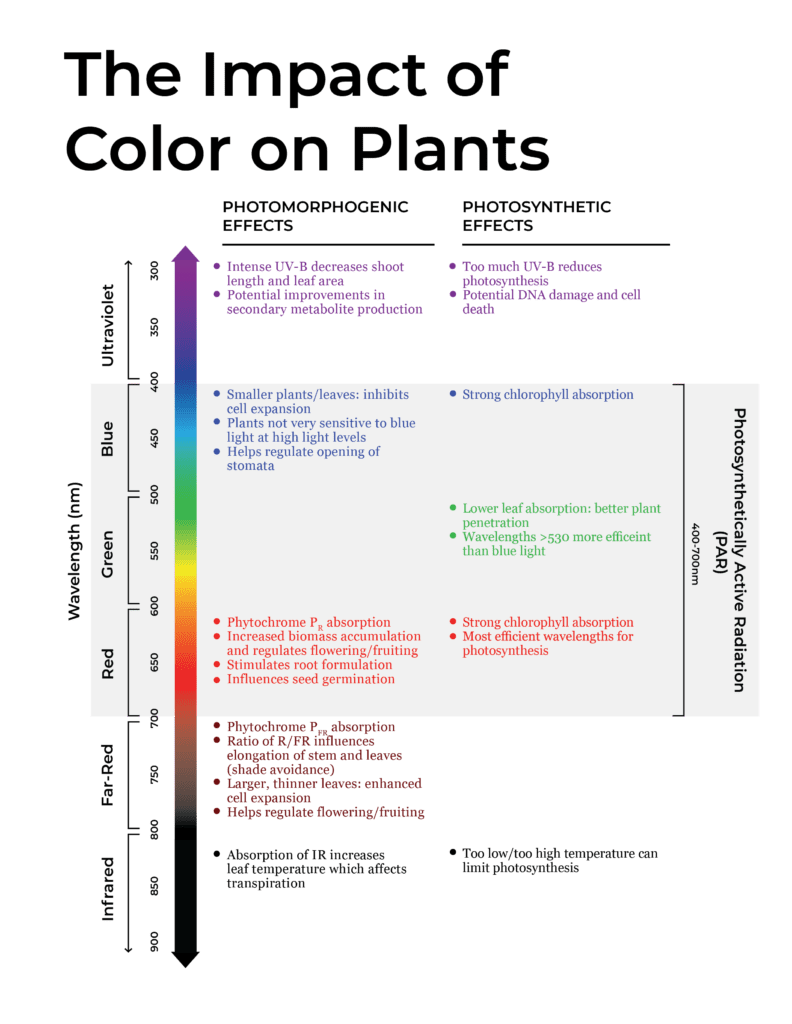

Hunter McDaniel, PhD
Founder & CEO
Hunter earned a Ph.D. in Materials Science and Engineering at the University of Illinois at Urbana-Champaign, before joining Los Alamos National Laboratory in the Chemistry Division. Ultimately the value proposition of UbiGro is about boosting crop yields and quality without the cost or energy impact of lighting. Hunter has more than fifty publications and patents, and more than 2000 total citations, h-index: 20. Hunter fundamentally believes that novel materials underpin every significant technology advancement, and he is focused on leveraging new materials to have a lasting and sustainable impact.

Damon Hebert, PhD
Director of Agriculture
Damon brings a wide range of experience in agriculture, materials science, spectroscopy, and small business. During his time in Prof. Angus Rockett’s research group at The University of Illinois at Urbana-Champaign (UIUC), Hebert authored a doctoral thesis and multiple papers on the materials science of CIGS semiconductor materials, which is closely related to the materials developed at UbiQD. He also served as a consultant to Nanosolar, a CIGS nanocrystal solar cell manufacturing company. Hebert has industry experience having co-founded Dr. Jolly’s, a leading cultivation and distribution operation in Bend, OR.

Tania Lafaille
Sales Representative
Tania is a UbiGro Sales Representative, with over 7 years of experience in product sales (specifically berries and avocados) covering all of North America and parts of South America. While in agriculture, Tania has cultivated strong relationships with growers and distributors, granting her a unique insight into both perspectives. That understanding, paired with her fierce dedication to results, drives her fun and fiery commitment to her craft. Tania is based in Gilroy, CA.

Tyler Veyna
Sales Representative
Tyler brings 15 years of experience in Greenhouse production and facility management of a wide range of crops in multiple states to the UbiGro team. Based in Salinas, California. “Being a fourth-generation farmer, I look to improve and empower the grower, and with UbiGro, we can do just that.”

Jim Gideon
Sales Manager
Jim Gideon is an UbiGro Sales Manager, with over 25 years of greenhouse industry sales experience covering all of North America. Previously Jim has worked for Green Tek, Plazit-Polygal, Texel, Cherry Creek, and Nexus. He is based in Montgomery, AL, and Jim believes that “light is everything to the grower.”

Eric Moody
Director of Sales
Eric Moody is UbiQD’s Director of UbiGro Sales. Eric has more than 6 years of experience in horticulture lighting industry, building relationships with greenhouse growers of all sizes and crops on optimal lighting for their growing operation, and most recently managed a North American sales team for PL Light Systems. Overall, Eric has been in sales leadership positions for more than 13 years. Eric brings with him a great understanding of the market and available technologies for growers, greenhouse facilities, and sales leadership. Reach Eric by phone at 541-490-6421 or by email at [email protected].

Mike Burrows, PhD
Dr. Michael Burrows is UbiQd’s Vice President of Business Development. His educational background includes a Materials Science doctorate from the University of Delaware and an MBA from Duke University Fuqua School of Business. His career has specialized in the commercialization of novel electronic materials in venture-run programs for different industries including solar, biosensors, and the automotive industry. In both start-up and corporate environments, he has extensive experience in global market development, foraging supply chain partnerships, productization, and brand building. He is currently leading UbiQD’s partnership efforts in luminescent greenhouse technology, smart windows, and security ventures.

Matt Bergern, PhD
Cheif Product Officer
As Chief Product Officer at UbiQD, Dr. Matt Bergren leads the company’s product development efforts, sales, and product manufacturing, including the company’s first commercial agriculture product, UbiGro. He plays a critical role in continuing the company’s path of technology development and vision of powering product innovations in agriculture, clean energy, and security.
He serves as the principal investigator for UbiQD’s contract with NASA, focused on tailoring the solar spectrum for enhanced crop production for space missions. Dr. Bergren’s leadership experience includes serving on the board of directors for the New Mexico Energy Manufacturing Institute, focused on job creation in New Mexico’s energy, and related manufacturing community.


